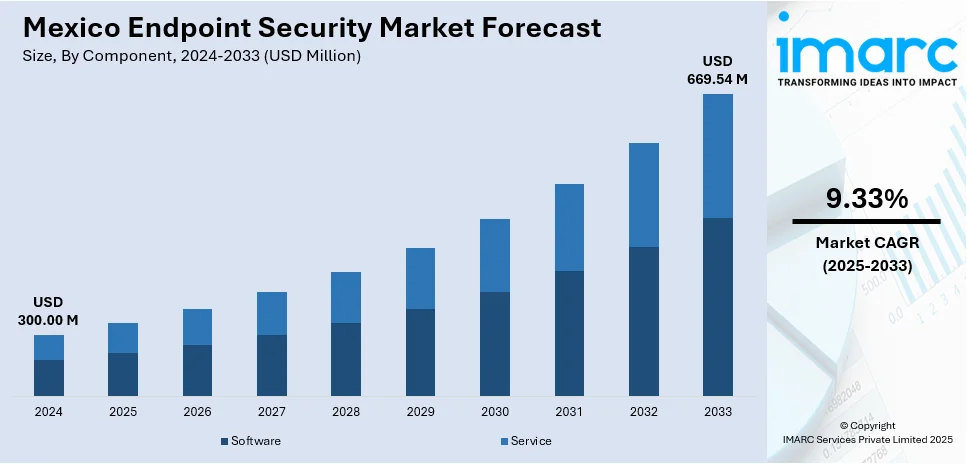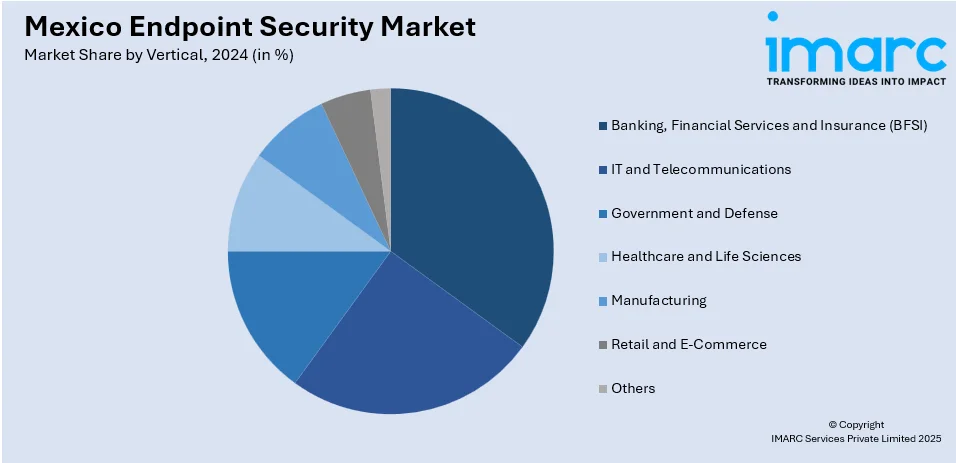
Mexico Endpoint Security Market Size, Share, Trends and Forecast by Component, Deployment Mode, Organization Size, Vertical, and Region, 2025-2033
Mexico Endpoint Security Market Overview:
The Mexico endpoint security market size reached USD 300.00 Million in 2024. Looking forward, IMARC Group expects the market to reach USD 669.54 Million by 2033, exhibiting a growth rate (CAGR) of 9.33% during 2025-2033. The market is driven by the rising cyber threats, stricter data protection regulations, and increased remote work adoption. Additionally, the shift toward Zero Trust frameworks and digital transformation across industries is fueling demand for advanced endpoint protection, particularly in finance, healthcare, and government sectors. Businesses increasing investments in cloud-based and AI-driven security solutions for better scalability and threat detection are also expanding the Mexico endpoint security market share.
|
Report Attribute
|
Key Statistics
|
|---|---|
|
Base Year
|
2024 |
|
Forecast Years
|
2025-2033
|
|
Historical Years
|
2019-2024
|
| Market Size in 2024 | USD 300.00 Million |
| Market Forecast in 2033 | USD 669.54 Million |
| Market Growth Rate 2025-2033 | 9.33% |
Mexico Endpoint Security Market Trends:
Increasing Adoption of Cloud-Based Endpoint Security Solutions
The market is experiencing a significant shift toward cloud-based solutions, driven by the growing need for scalable and remote security management. As businesses increasingly adopt hybrid work models, traditional on-premises security tools are proving insufficient to protect distributed endpoints. The Mexican workforce is adapting to hybrid work patterns in anticipation of rising wages. According to industry reports, over half of the 59.7 million employees in Mexico are Millennials and Gen Z, and hybrid work arrangements are becoming prevalent. A 20% raise in the minimum wage, now at MXN$ 375 (approximately USD 19.22) on the northern border, is pushing firms to revisit their labor costs while improving endpoint security protocols to enable remote working. With more competition for professionals, businesses are forced to innovate to keep employees in a volatile economic environment. Cloud-based endpoint detection and response (EDR) and extended detection and response (XDR) platforms are gaining traction due to their ability to provide real-time threat monitoring, automated responses, and centralized visibility across devices. Additionally, small and medium-sized enterprises (SMEs) in Mexico are turning to cloud security solutions for their cost-effectiveness and ease of deployment, eliminating the need for extensive hardware investments. With cyber threats becoming more sophisticated, organizations are prioritizing advanced cloud-native security tools that offer AI-driven analytics and seamless integration with other cybersecurity frameworks. This trend is expected to accelerate as more Mexican businesses undergo digital transformation and seek flexible, robust security measures.

Rising Demand for Zero Trust Security Frameworks
The increasing adoption of Zero Trust security models, which operate on the principle of "never trust, always verify, "positively influences the Mexico endpoint security market growth. As cyberattacks, including ransomware and phishing, rise across the country, organizations are moving beyond traditional perimeter-based defenses. Mexico is facing a rise in cyber attacks, with 77% of state-sponsored phishing attacks being leveled by China, Russia, and North Korea. Ransomware campaigns are most targeted at the manufacturing, finance, and government sectors, making Mexico the second most affected nation in Latin America. Cyber attackers are using tax schemes, including SAT impersonation and banking trojans, increasing the need for fraud discovery in financial services. While Chrome OS has a zero record of ransomware attacks, the number of malware campaigns through malicious PDFs and fake utilities identifies the critical need for Zero Trust security models in Mexico's digital economy. Zero Trust architectures enforce strict identity verification, least-privilege access, and continuous monitoring of endpoint devices, reducing the risk of unauthorized access. Mexican enterprises, particularly in finance, healthcare, and government sectors, are implementing Zero Trust Network Access (ZTNA) and multifactor authentication (MFA) to strengthen endpoint security. The Mexican government’s push for stricter data protection regulations is also encouraging businesses to adopt Zero Trust principles. Furthermore, as remote work persists, companies recognize the need to secure endpoints beyond corporate networks, making Zero Trust a critical component of their cybersecurity strategy. This trend is expected to grow as awareness of its effectiveness in mitigating insider threats and external breaches increases.
Mexico Endpoint Security Market Segmentation:
IMARC Group provides an analysis of the key trends in each segment of the market, along with forecasts at the country and regional levels for 2025-2033. Our report has categorized the market based on component, deployment mode, organization size, and vertical.
Component Insights:
- Software
- Service
The report has provided a detailed breakup and analysis of the market based on the component. This includes software and service.
Deployment Mode Insights:
- On-premises
- Cloud-based
A detailed breakup and analysis of the market based on the deployment mode have also been provided in the report. This includes on-premises and cloud-based.
Organization Size Insights:
- Large Enterprises
- Small and Medium-sized Enterprises
The report has provided a detailed breakup and analysis of the market based on the organization size. This includes large enterprises, and small and medium-sized enterprises.
Vertical Insights:

- Banking, Financial Services and Insurance (BFSI)
- IT and Telecommunications
- Government and Defense
- Healthcare and Life Sciences
- Manufacturing
- Retail and E-Commerce
- Others
A detailed breakup and analysis of the market based on the vertical have also been provided in the report. This includes banking, financial services and insurance (BFSI), IT and telecommunications, government and defense, healthcare and life sciences, manufacturing, retail and e-commerce, and others.
Regional Insights:
- Northern Mexico
- Central Mexico
- Southern Mexico
- Others
The report has also provided a comprehensive analysis of all the major regional markets, which include Northern Mexico, Central Mexico, Southern Mexico, and others.
Competitive Landscape:
The market research report has also provided a comprehensive analysis of the competitive landscape. Competitive analysis such as market structure, key player positioning, top winning strategies, competitive dashboard, and company evaluation quadrant has been covered in the report. Also, detailed profiles of all major companies have been provided.
Mexico Endpoint Security Market News:
- March 13, 2025: Kaspersky inaugurated a Cyber Research Center at KidZania Santa Fe in Mexico City, aiming to teach kids about the fundamentals of cybersecurity and digital security by participating in interesting, hands-on activities. Through this, Kaspersky hopes to raise awareness of online security, privacy, and protection from digital risks such as fraud and identity theft. The center will enable thousands of youth visitors annually to assume the responsibility of being positive agents for cybersecurity.
Mexico Endpoint Security Market Report Coverage:
| Report Features | Details |
|---|---|
| Base Year of the Analysis | 2024 |
| Historical Period | 2019-2024 |
| Forecast Period | 2025-2033 |
| Units | Million USD |
| Scope of the Report |
Exploration of Historical Trends and Market Outlook, Industry Catalysts and Challenges, Segment-Wise Historical and Future Market Assessment:
|
| Components Covered | Software, Service |
| Deployment Modes Covered | On-premises, Cloud-based |
| Organization Sizes Covered | Large Enterprises, Small and Medium-sized Enterprises |
| Verticals Covered | Banking, Financial Services and Insurance (BFSI), IT and Telecommunications, Government and Defense, Healthcare and Life Sciences, Manufacturing, Retail and E-Commerce, Others |
| Regions Covered | Northern Mexico, Central Mexico, Southern Mexico, Others |
| Customization Scope | 10% Free Customization |
| Post-Sale Analyst Support | 10-12 Weeks |
| Delivery Format | PDF and Excel through Email (We can also provide the editable version of the report in PPT/Word format on special request) |
Key Questions Answered in This Report:
- How has the Mexico endpoint security market performed so far and how will it perform in the coming years?
- What is the breakup of the Mexico endpoint security market on the basis of component?
- What is the breakup of the Mexico endpoint security market on the basis of deployment mode?
- What is the breakup of the Mexico endpoint security market on the basis of organization size?
- What is the breakup of the Mexico endpoint security market on the basis of vertical?
- What is the breakup of the Mexico endpoint security market on the basis of region?
- What are the various stages in the value chain of the Mexico endpoint security market?
- What are the key driving factors and challenges in the Mexico endpoint security market?
- What is the structure of the Mexico endpoint security market and who are the key players?
- What is the degree of competition in the Mexico endpoint security market?
Key Benefits for Stakeholders:
- IMARC’s industry report offers a comprehensive quantitative analysis of various market segments, historical and current market trends, market forecasts, and dynamics of the Mexico endpoint security market from 2019-2033.
- The research report provides the latest information on the market drivers, challenges, and opportunities in the Mexico endpoint security market.
- Porter's five forces analysis assist stakeholders in assessing the impact of new entrants, competitive rivalry, supplier power, buyer power, and the threat of substitution. It helps stakeholders to analyze the level of competition within the Mexico endpoint security industry and its attractiveness.
- Competitive landscape allows stakeholders to understand their competitive environment and provides an insight into the current positions of key players in the market.
Need more help?
- Speak to our experienced analysts for insights on the current market scenarios.
- Include additional segments and countries to customize the report as per your requirement.
- Gain an unparalleled competitive advantage in your domain by understanding how to utilize the report and positively impacting your operations and revenue.
- For further assistance, please connect with our analysts.
 Request Customization
Request Customization
 Speak to an Analyst
Speak to an Analyst
 Request Brochure
Request Brochure
 Inquire Before Buying
Inquire Before Buying




.webp)




.webp)












